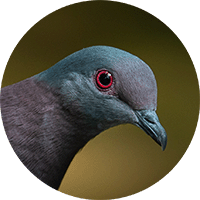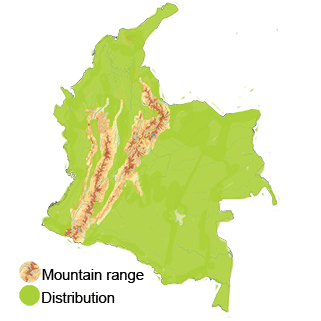Pale-vented Pigeon
The Pale-vented Pigeon (Patagioenas cayennensis). Read in Spanish
Appearance: The Pale-vented Pigeon is a medium-sized pigeon species with a distinctive appearance. It typically has a grayish-blue plumage, a white throat, and a pale vent (lower belly area). The species also features red legs and a red bill with a dark tip. Both male and female pigeons exhibit similar plumage characteristics.
Habitat: Pale-vented Pigeons are commonly found in a range of habitats, including tropical and subtropical forests, woodlands, and forest edges. Here they inhabit various forested areas, including lowland rainforests and montane forests.
Behavior: These pigeons are often seen in pairs or small groups, foraging for fruits, seeds, and occasional insects. They are relatively shy and cautious birds, typically perching in trees and using their keen eyesight to scan their surroundings. Pale-vented Pigeons may produce characteristic cooing sounds as part of their communication.
Breeding: The breeding season for Pale-vented Pigeons can vary based on the region and environmental factors. They construct simple nests made of twigs and leaves in trees for breeding purposes. The female typically lays one or two eggs per clutch, which are incubated by both parents.
Conservation Status: The conservation status of the Pale-vented Pigeon in Colombia is generally stable, and the species is not considered globally threatened.
Distribution
The Pale-vented Pigeon (Patagioenas cayennensis), also known as the Pale-vented Pigeon or White-tipped Dove, is a species of pigeon found in various habitats in Colombia.
Northern Andes Region: The Pale-vented Pigeon can be found in the northern Andes region of Colombia, including areas such as the Sierra Nevada de Santa Marta and the Sierra Nevada del Cocuy. This species inhabits forested areas, cloud forests, and mountainous regions with dense vegetation, where it feeds on fruits, seeds, and foliage.
Magdalena Valley Region: In the Magdalena Valley region of Colombia, which includes cities like Ibague, Neiva, and Villavicencio, the Pale-vented Pigeon can be encountered in lowland and foothill forests. The species may also occur in riparian habitats, gallery forests, and areas with a mix of open spaces and wooded areas.
Eastern Plains (Llanos) Region:
The Pale-vented Pigeon is present in the eastern plains or Llanos region of Colombia, characterized by vast grasslands, savannas, and wetlands. In this region, the species may be found near rivers, streams, and forest edges, where it can find roosting and nesting sites.
Amazon Rainforest Region: Within the Amazon Rainforest region of Colombia, which encompasses areas like Leticia and regions bordering Brazil and Peru, the Pale-vented Pigeon inhabits dense tropical forests. It prefers primary and secondary forests with a diverse canopy structure and rich plant diversity, providing ample food resources.
Pacific Coast Region: Along the Pacific coast of Colombia, including areas like Buenaventura, Tumaco, and Guapi, the Pale-vented Pigeon can be found in montane forests and coastal lowlands. This species may frequent mangrove forests, riverine habitats, and forested slopes near the coast.
Taxonomy
The Pale-vented Pigeon (Patagioenas cayennensis)
- Kingdom: Animalia
- Phylum: Chordata
- Class: Aves (Birds)
- Order: Galliformes
- Family: Odontophoridae
- Genus: Patagioenas
- Species: Patagioenas cayennensis
Vocalization
The Pale-vented Pigeon (Patagioenas cayennensis)
- Advertising Coo: Similar to other pigeon species, the Pale-vented Pigeon produces a soft, rhythmic cooing sound that serves as an "advertising coo." This vocalization is often used by males to attract females and establish territories. The cooing call of the Pale-vented Pigeon can be melodious and repetitive, varying in intensity and pitch.
- Nesting Calls: During the breeding season, Pale-vented Pigeons may emit specific vocalizations associated with courtship and nesting behaviors. These calls are often softer and more intimate, signaling communication between mates or between parents and offspring.
- Agitated Calls: When disturbed or threatened, Pale-vented Pigeons may produce agitated calls that are louder and more rapid than their usual cooing sounds. These agitated calls serve as warning signals to other pigeons in the vicinity about potential danger.
- Flight Calls: While in flight, Pale-vented Pigeons may vocalize with short, sharp calls or wing beats that create distinctive noises. These flight calls help coordinate movements within a flock and may also communicate flight directions or warnings.
- Contact Calls: Pale-vented Pigeons use contact calls to maintain communication with flock members or to locate each other within their shared habitat. These calls are often softer and occur at regular intervals, enabling pigeons to stay connected while foraging or moving through their environment.
- Alarm Calls: Like many bird species, the Pale-vented Pigeon has specific alarm calls that signal potential threats in the surroundings. These alarm calls are sharp, loud, and urgent, prompting other pigeons to be alert and vigilant in response to perceived dangers.





